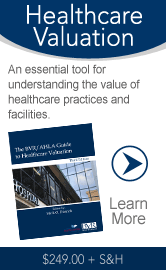 |
 |
Issue #25-1 | July 17, 2014

Healthcare M&A focus shifts to valueAn alternative M&A strategy known as “value-focused acquisition and affiliation” is emerging in healthcare, as hospitals look more toward improving the quality or cost-effectiveness of care as opposed to market domination. This is revealed in a new report, Acquisition and Affiliation Strategies, which is based on a series of interviews conducted by the Healthcare Financial Management Association. Mergers of equals: HFMA received 145 total responses to a survey sent to a random selection of its senior financial executive members in October 2013. Half of the respondents represented stand-alone hospitals, and half represented health systems. The hospital acquisitions trend may be “shifting toward mergers and acquisitions that take place between financial equals,” as opposed to more traditional acquisitions in which a stronger healthcare system acquires a weaker one, says the report. The research also suggests several “defining characteristics” of acquisition and affiliation activity in the current marketplace:
Improvements to expect: The report also identifies the following eight ways financial executives expected improvement in capabilities as the result of an acquisition or affiliation.
Consolidation coming for urgent care centers During their webinar presentation, Fair Value Market Trends for Urgent Care Centers, on June 24, Elliott Jeter and Corey Palasota (both VMG Health) shared their observations about this sector of the industry:
“Urgent care centers are going to be a hot segment going forward. Hospitals are interested in partnering with honest, qualified physicians,” says Palasota. For more information about the webinar, click here. Extra: Urgent care has exploded into an estimated $14.5 billion business, as investors try to cash in on the changes in healthcare, according to an article in The New York Times, “The Race Is On to Profit From Rise of Urgent Care.” Hospital margins narrowed in 2013 The average operating margin in 2013 for U.S. hospitals was 3.1%, down from 3.6% in 2012, according to an analysis of the earnings reports of 179 health systems by Modern Healthcare. Revenue pressures: More than 60% of the analyzed systems saw their operating margins "deteriorate" from 2012 to 2013. Experts attribute the narrowing margins to increasing revenue pressures. Patient care revenue is being squeezed as Medicare and insurers attempt to reduce utilization and spending. At the same time, systems are investing in expensive technologies and new payment models. To see the analysis, click here (subscription required) Impact of new payment scheme on healthcare providers Payers and hospitals expect that, within five years, new value-based payment models will eclipse the traditional fee-for-service model, reveals a new survey. They anticipate that two-thirds of payments will be based on complex reimbursement models with value measures by 2020, according to a new study commissioned by McKesson and conducted by ORC International. The study, the 2014 State of Value-Based Reimbursement, found that 90% of payers and 81% of hospitals currently offer a mix of fee-for-service and other reimbursement models. To get a copy of the study, click here (free registration required). Financial impact: How will value-based reimbursement models impact the financial health of payers and healthcare providers? The study found 60% of payers believe making the transition to value-based care will have a positive financial impact on their organizations. At the same time, only 35% of providers believe value-based models will have a positive impact financially. Patient portals top list of hospitals' IT investment plans Investing in patient portals is the most-cited IT strategy for hospitals that use electronic health record (EHR) systems, according to a survey from Software Advice. The survey gave hospitals a list of EHR-related modules and asked whether their level of investment would increase this year.
Extra: Moody's Investors Service says that not-for-profit hospitals should boost IT spending as one of the ways to manage the shift in declining patient utilization rates. New study reveals no evidence of upcoding A concern over the growth of electronic health records (EHRs) has been that hospitals could be upcoding, that is, using these systems to increase patient acuity scores to increase reimbursements. However, this does not appear to be happening. New study: There is no evidence suggesting hospitals are systematically upcoding to increase Medicare reimbursement, according to a study in the July issue of Health Affairs. The study hypothesized that for-profit hospitals, hospitals in highly competitive markets. and hospitals with a high percentage of Medicare patients would be the most likely to change their coding practices. While the study did find that hospitals that adopted EHRs increased billing to Medicare, it was at a rate comparable to non-EHR adopters. “Our findings should reduce concerns that EHR adoption by itself will increase the costs of hospital care,” say the study’s authors. Extra: EHRs do pose an audit risk because of the shortcuts they provide. For example, copied and pasted chart notes don’t always accurately reflect what happened during a patient’s visit, which can flag auditors to an inaccurately billed claim. An MGMA blog gives tips on how to avoid a coding audit. Physicians seek informal PHOs, ACOsMore than 40% of medical practices are seeking an informal integration with a hospital or health system, according to research released by the Medical Group Management Association. This includes clinical integration with a hospital and forming or joining a physician-hospital organization, accountable care organization, or independent practice association. Just 27% of medical practices surveyed for the research plan on formally integrating or merging with another practice or selling to a hospital or health system. "Physician practices are seeking ways to work better with other care providers, and affiliating informally or clinically integrating with other organizations allows practices to adapt as needed and position themselves for success in a value-based environment," Susan L Turney, MD, MGMA president and CEO, said in a release. PHO guide: The Essential Guide to Physician-Hospital Organizations: 7 Key Elements for PHO Success describes the seven critical areas of PHO development, from defining the PHO mission to creating a data environment conducive to registry use, analytics, and active patient management. Webinars of interest BVR is conducting an Online Symposium on Healthcare Valuation, which focuses on the challenges inherent in valuations in medicine, life sciences, and healthcare. Here are some upcoming webinars in this series:
|
|
||||||
Business Valuation Resources, LLC
1000 SW Broadway, Suite 1200, Portland, OR 97205
(503) 291-7963 | editor@bvhealthcarenews.com
bvresources.com/healthcare

